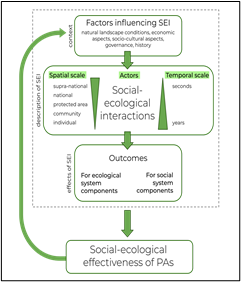Exploring the Social-ecological Effectiveness of Protected Areas - A Case Study from North Luangwa, Zambia
Marina Frietsch
Protected areas are social-ecological systems in which interactions between people and nature drive most dynamics and outcomes. They are established with the goal to contribute to biodiversity conservation and human well-being. The extent to which a protected area contributes to the achievement of these goals determines its degree of social-ecological (in)effectiveness. Many protected areas around the world exhibit low levels of social-ecological effectiveness, reflected for example by widespread habitat conversion, and biodiversity loss. I developed a toolkit which facilitates the thorough understanding of social-ecological effectiveness in protected areas. These insights can then be used to derive meaningful, site-appropriate actions that foster social-ecological effectiveness. Because of their significant impact on protected areas, I used social-ecological interactions (e.g., human-wildlife conflicts, emotional connections to specific ecosystem components) to approach the social-ecological effectiveness of protected areas. To this end, I investigated a case study encompassing two different categories of protected areas in Zambia, considering system-specific social-ecological interactions. I developed an analytical framework for disentangling social-ecological interactions. Using this framework, I elucidated three dimensions of social-ecological interactions occurring in the study area: care, conflict, and use. Relationships between these interactions and associated key variables were visualized in a causal loop diagram. Finally, I proposed 49 indicators for 18 system elements central to the social-ecological structure of the study area. The analytical framework developed, and the indicators identified in this study can be applied to other protected areas. Here, depending on the respective system dynamics, the indicators might need to be adapted to the new context before their application.

Analytical framework. The three components in the dashed box are designed to analyze social-ecological interactions according to their context, description, and effects. Together, they provide a comprehensive picture of specific SEI that shape the study SES and thereby influence its effectiveness. The social-ecological effectiveness of a PA, in turn, can influence the context in which SEI occur.

Causal loop diagram of dynamics in the study area. Blue arrows with a “+” represent relationships between variables with an enhancing effect, meaning that the variables move in the same direction. Orange arrows with a “-” indicate relationships with a reducing effect, indicating that they move in opposite directions. SEI are highlighted with black boxes.
